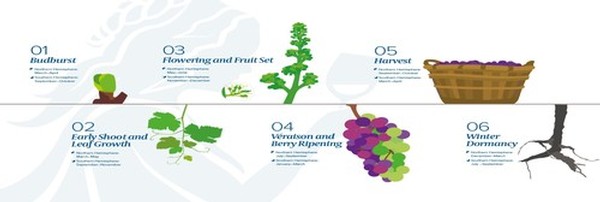What does a Winemaker do in the Winter?
The cycle of a winemaker’s year is very apparent in the non-winter months with bottling and opening wineshops in the spring, grape growing in the summer, and harvest and vintage in the fall. But what does a winemaker do in the winter? It’s more than you think,

Yes, winemaker activity closely follows the cycle of the vine, illustrated above from an article by Wine & Spirit Education Trust. But a winemaker is definitely not dormant like the vine in winter. Here are typical activities that keep me busy in January, February and March.
January
- Fermentation – most ferments are finished by December but we quite often have several wines still popping away in January. The old saying is you need to know more to do less and shepherding the wines to their potential means lots of monitoring!
- Filtration – we use a cellulose pad filter to clarify wines and those finished cloudy, yeasty ferments get ample time to settle before we progressively filter them to finer and finer levels.
- Bentonite – a natural clay called bentonite helps clarify and protein stabilize wines. It is an important part of making vegan wine. Each wine has a bench trial in the lab to determine its individual bentonite requirement before it is added in the cellar.
- Blend Trials – harvest and vintage is a very busy time in the cellar and we try keep as many options open as possible so that we can measure, taste, calculate and blend (repeat) later. It starts in December when we have the most family palates available to give opinions on sparkling blends, Tidal Bay and many other blends. We usually submit a tank sample for the Tidal Bay taste panel in January. And order our sparkling bottles from France.
- Excise and other compliance requirements – count, count, count: inventories of tiraged sparkling, bulk tanks and finished wines and tonnage from previous year for Excise, NSLC and NS Agriculture reports. These reports become an important part of traceability audits
for our certified organic wine inspections. Many permits are due for renewal this month.
February
This is the time of year when Mother Nature gives Nova Scotia a full-on winter. The influential “warm” Bay of Fundy gets chilled to 5-6C and we feel it. Our vineyard manager and crew start pruning our Gaspereau vineyard on the best days, and tanks and barrels of wine in the cellar chill naturally.
- Wine Shows – luckily wine trade understands the cycle of a winemaker and many festivals, trade shows and educational symposiums are scheduled in February. We went to the Vancouver Wine Festival three years in a row before the pandemic, my home province.
- Packaging – planning, and ordering, labels, closures, cartons, shippers. We start bottling new vintage wines in April.
- Disgorging – even if we disgorge traditional method sparkling every week in November/December we usually need to do it again in February for orders. And for wine competitions, especially international.
March
- Wineshop and Tasting Room – start hiring and planning for the season opening of our wineshop, wine tastings and wine tours. This always seems to come early, and as the shoulder season gets busier in our emerging wine region perhaps late April opening will be normal in the future.
- Organic and Biocyclic Vegan certification renewal – we submit our plans for the whole year of winemaking and viticulture activities and inputs. It is a lot of work by myself and our vineyard manager as we reflect on the past year’s successes and areas for improvements. We follow the plan all season, document everything and get inspected in the fall.
- Online Store and Wine Clubs – we open our online store and ship across Canada weather permitting. We start planning allotments for wine club members – three shipments/year, May, August and November.
- Bottle Charmat Method sparkling – this is new for our winery and the cycles of sparkling production in our two specialized charmat tanks include a March bottling after sitting on its yeast lees for 3-4 months.
